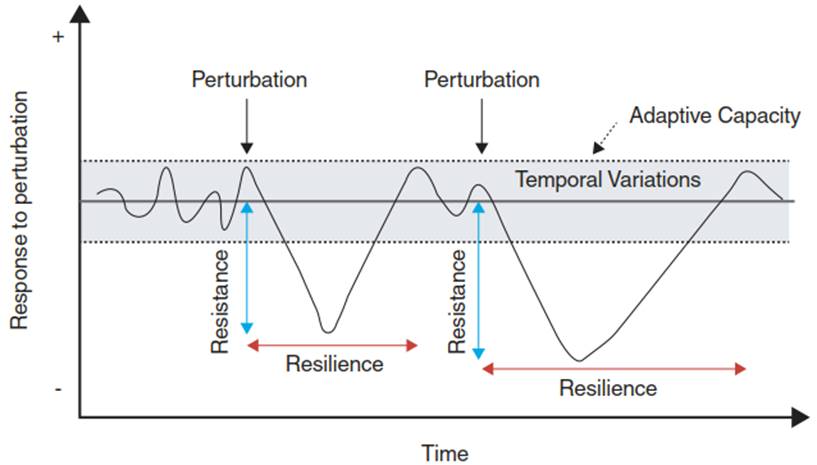Concepts of Equilibrium, Resistance and Resilience, Susceptibility and Vulnerability
The idea that ecosystems are in equilibrium with their environment (Gleason 1926) has been proven incorrect. Short- and long-term variability of the environment and the occurrence of disturbances not only constantly change the environment but also cause continuous adjustments of biogeochemical and ecophysiological processes and changes in species composition. Thus, also steady-state conditions— that is, the state when processes or characteristics are not changing over time—are rare on longer time scales. Although an ecosystem is constantly subjected to sudden disturbances and slow-changing drivers, not all of these events trigger a response at the ecosystem level.
The number of events or reoccurrence of events per time unit, i.e. the frequency, but also the strength of an event, i.e. the intensity, or the dose, i.e. intensity x time duration, are decisive and, together with certain ecosystem properties (see below), determine if an ecosystem is changing in response to an event or not. In the current literature, the terms “shock” and “extreme event” are also used to describe a (sudden) event or disturbance (Reichstein et al. 2013; Frank et al. 2015).
In order to decide if an unusual or statistically rare disturbance or an extreme event has happened, it is necessary to know the typical/normal variability of the occurrence of disturbances or weather events. Sometimes also a combination of events is of interest, such as a combined heatwave and drought, as occurred in Central Europe in 2003, or a combined drought and insect outbreak. This means that long-term data sets of many variables are necessary, although sometimes not available. Furthermore, lagged versus non-lagged (also called concurrent) responses of an ecosystem to an event are differentiated, depending on when the ecosystem responds to a disturbance or change (Smith 2011). Additional terms used for lagged responses are legacy effects and memory effects, the latter of which should be avoided because of its human connotation.
The concept of stability includes a variety of aspects, all describing how an ecosystem reacts to or withstands internal or external perturbations. Although there are many definitions of stability (163 according to Grimm and Wissel (1997)), the response to and recovery after a perturbation are decisive in describing stability (Fig. 13.5). If an ecosystem is not reacting to a disturbance or environmental change and stays at its current state, this ecosystem is resistant to the disturbance or change. It retains its structure, and the current processes and species composition of the ecosystem will also continue in the future. This typically happens only when the event is not very strong in terms of either frequency, intensity or dose. If the event is stronger, more frequent or lasts longer, the resistance must increase to maintain the ecosystem’s current state.

Fig. 13.5. Different aspects of stability. The resistance and resilience of the ecosystem to the first perturbation are higher than those to the second perturbation. In the second case, the ecosystem needs much longer to recover from the perturbation than in the first case. Resistance and resilience are two aspects of stability that are widely used today (sometimes also called resistance and resilience stability, respectively). However, many more definitions and special cases do exist
On the other hand, if the ecosystem is able to adapt to these perturbations (e.g. to changes in the environment), recovers over time and thus does not lose species or the capacity to carry out certain processes permanently, this ecosystem is resilient to change. It reacts to the disturbance but persists within its boundaries and thus is rather robust. If a perturbation event is even more severe, occurs in combination with other(s) or is of a new type that the ecosystem has not experienced yet, the ecosystem might not have the adaptive capacity (also called buffering capacity) to withstand or dampen such an event and might thus be transformed into another state. Thus, under these conditions, the ecosystem loses its capacity to function, changes its species composition or both. Nevertheless, one has to keep in mind that resistance or resilience are not inherently beneficial characteristics of an ecosystem. For example, restoration of a degraded ecosystem would likely benefit from less resistance or resilience in the system.
To describe the potential or the probability of this change in state, additional concepts have been developed: susceptibility and vulnerability. Both terms are often used as synonyms, although there is a difference. While susceptibility only considers the impact on (in our case) an ecosystem, vulnerability also takes into account the probability of the disturbance or change happening. Thus, an ecosystem is called susceptible or vulnerable to a disturbance or change if its resilience is small or already impaired, or if one expects this ecosystem to change soon and lose its current species composition and/or function. Climate change is often mentioned in this respect because of the projected change in the frequency of extreme weather and climate events.
Date added: 2025-02-05; views: 276;
